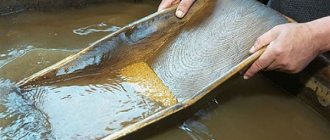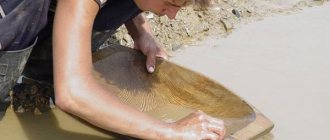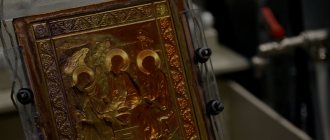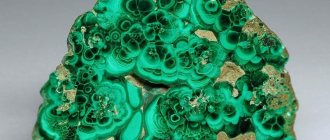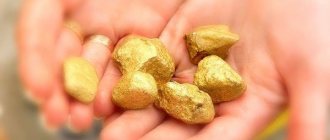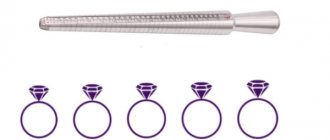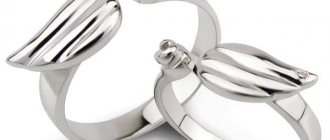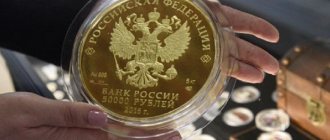Mining is an activity aimed at extracting mineral-containing substances from the depths of the earth or from its surface and processing them to obtain finished products. Gold mining is a priority in this area. This is largely due to the preciousness of the metal and its influence on the state of the gold and foreign exchange reserves of any country. Therefore, the gold mining industry occupies a special place in the system of state development, and new technologies are being developed and implemented to improve it.
Where do miners find gold in Russia?
The largest Au deposits are located in the Far East and Eastern Siberia. The third place is occupied by the Urals.
Below is a list of rivers containing the largest reserves of the yellow metal - this is where I recommend finding and washing it.
Yellow metal satellites
Companion rocks that play the role of “witnesses”, suggesting that gold-bearing veins are somewhere nearby:
- silver;
- pyrite;
- quartz;
- lead;
- galena.
Pyrite is the most insidious companion of gold, because beginners often cannot distinguish it from a real noble metal: they find a mass of pyrite crystals and rejoice at the happiness that has fallen on their heads, and then they are disappointed.
Meanwhile, gold can not only be washed from the river, but also found inside inconspicuous-looking pieces of rock scattered along the shore. If a piece of mineral glitters with a yellow tint that does not change when light is refracted, there is most likely gold inside. This breed should be crushed and washed.
Why do they wash gold in the river?
Extracting gold from the river is the most accessible way for single miners to get hold of the precious metal. To find it in river beds and wash it out of rock, you do not need to purchase expensive equipment and hire personnel, as with industrial mining from the subsoil.
There is definitely Au in the rivers flowing near gold deposits; there is a simple popular scientific explanation for this. Temperature changes and other natural phenomena destroy gold-bearing ores, small particles of the precious metal are washed away by rain, melt and flood waters into rivers and streams. After which, being heavy, gold settles in certain places:
- terrace deposits are found on rapids and sills that rise above the level of the banks of watercourses, as well as in dry riverbeds;
- Bottom placers should be looked for in bedrock channels (in valleys);
- spit deposits are formed on river spits, whether sandy or pebbly.
It is good to find and wash small gold grains and large or small nuggets in bedrock, places where the flow of water slows down (the mouths of mountain streams, turns of riverbeds), natural “traps” (near boulders lying in a mountain river, on shallows, in pits under waterfalls, near fallen trees blocking the river flow).
Non-industrial extraction methods
So, gold has been found, but most often gold nuggets have impurities, for example, silver or quartz. Or during mining you get too small particles of gold mixed with sand or concentrate. In order to extract gold without the use of industrial equipment, there are three main ways:
- amalgamation with mercury;
- cyanidation;
- chlorination.
The first method is used if the gold fractions do not exceed a millimeter in diameter. The technology is simple: the metal is dissolved in mercury and an amalgam is obtained. Then the rock is separated using a fine mesh. About half of the resulting solution contains gold; it is obtained by evaporating the solution. Now this method is not very often used due to the fact that the gold obtained is not very pure, and also because mercury fumes are very harmful to humans.
The second method involves leaching, concentration and purification of the metal. Leaching occurs due to the interaction of cyanide with oxygen, after which the concentrate is removed using activated carbon, filtered and calcined. In this case, it is possible to obtain a purer metal, but cyanide vapor is even more dangerous than mercury vapor. In essence, zoning is a hydrometallurgical process. At first, only potassium cyanide was used for this method, then they also switched to calcium cyanide. In addition, it was found that fine crushing gives better results compared to coarse crushing.
The third method involves the use of hydrochloric acid and chlorine, which dissolve the gold, after which it is fused into an ingot.
Is it possible to mine gold in Russia?
Until 2016, only large legal entities had the right to engage in gold mining. The activities of private miners who dared to wash the precious metal were completely illegal and criminally punishable.
Currently, private individuals have the right to extract gold from deposits - under two conditions:
- individual entrepreneur registration;
- availability of a license or agreement with a gold mining organization that has all the permits for the development of gold mines.
Obtaining a license is a long and troublesome procedure; concluding an agreement with a licensed gold mining company is a much simpler path.
Industrial mining of precious metals brings companies quite high incomes. And private miners who want to pan for gold using the artisanal method are not competitors for them. So we can reach an agreement.
What laws regulate gold mining?
Business entities have the right to engage in gold mining in the Russian Federation, guided by the federal law “On Subsoil”, after the adoption of a number of amendments allowing both legal entities and individual entrepreneurs to mine gold from the beginning of 2022. Any private miner is given the opportunity to rent a plot of land of up to 0.15 square meters for a specified period, which is enough to extract up to 10 kilograms of precious metal.
A few more conditions must be met:
- obtain metal only by surface method;
- exclude the use of explosives;
- take soil only up to 5 meters deep.
If you wash precious metals without a license or an agreement with a company that has one, this activity is still punishable under Art. 191 of the Criminal Code of the Russian Federation. And violation of these requirements threatens with serious sanctions.
Permitted Miner's Tools
Tools that help you find and wash precious metals:
- Mini-drag for pumping rock from the bottom of the river (no deeper than 5 m) and washing it away.
- A tray in which it is convenient to wash the rock by hand.
- A metal detector that detects the presence of metal in the soil. A conventional device reacts not only to gold, but also to any metal, so I advise you to use a special metal detector with a sensor that can be easily configured specifically to search for gold.
What is a tray and why do you need a magnet?
A tray is a special device for washing rock and separating Au from it. With it you can do without a mini-dredge and get soil out of the river with an ordinary shovel.
The magnet helps separate black sand from base metals from Au.
In addition to the tray and magnet, I advise you to purchase a bulb bottle, which helps you easily remove precious particles from the tray at the last step of lathering.
It is more convenient to place gold grains in a glass bottle.
Homemade Eldorado
Even knowing the places and methods of gold mining, an individual cannot now count on unconditional success. Freezing in rivers for months or swinging a crowbar is a dubious pleasure. But you can try to open your own Eldorado at home, in the garage, in the country.
Not a new, but proven method is the use of a mixture of nitric and hydrochloric acid (familiar from the school course on “regia vodka”):
- First you need to buy reagents and collect those items from which you can “smelt” aurum. These are radio components, gold-plated watch cases, SIM cards, dental crowns.
- Place the household “ore” in a safe container and pour the acid mixture over it. It should dissolve everything except Au.
- A golden film forms on the surface. You can try to remove it or strain the solution through gauze folded in several layers.
- Rinse the “Golden Reserve” in regular vodka, and then melt it in a frying pan. At this stage you need to add a little soda. The result will be a small ingot of precious metal.
This work is quite dangerous. Therefore, you will need rubber gloves and a gauze mask. Eyes need to be protected with glasses. And, of course, there is no point in starting a home laboratory with only a couple of SIM cards or an old watch on hand - the size of the “boot” directly depends on the number of consumables and materials. Theoretically, you can go by evaporating Au even from tap water, but this will require absolutely fantastic volumes.
The pursuit of the noble metal has advanced human civilization, its science, and geography. Now it is forcing people to study the oceans more closely. Almost every year you hear about some new sensation - even “golden” bacteria have been discovered and are now being bred.
How to properly wash gold with a tray
Now that we've sorted out the tools, I'll describe the technology for panning gold by hand.
It consists of three washing stages:
- large rocks and dirt;
- gravel and ordinary sand;
- black sand.
Washing away dirt and large rocks
- Fill the tray three-quarters full with rock, dip it into the stream so that the edges are above the surface of the water.
- Shake the tray back and forth and left and right, sharply but gently, without shaking out the gravel.
- After several shakes, we rotate the tray, moving the gravel in a circle, while most of the dirt inside dissolves.
- We remove the moss and roots and rub them over the tray with our fingers, checking to see if there are any gold particles in them.
- We take out large stones and check if they are washed.
We continue to wash with shaking and circular movements until large rocks and dirt are removed.
Washing out sand and gravel
- Holding the tray above the water surface, tilt it slightly away from you.
- We rotate it, shaking it from time to time in an upward motion, as if tossing a steak in a frying pan, but without throwing out the gravel and not letting it wash over the edge.
- Shake the tray (still in water) back and forth.
- Repeat steps 1-3 to thoroughly rinse the contents of the tray until only heavy rock remains at the bottom.
It consists of black sand, which, if the miner is lucky, contains grains of gold.
Washing out black sand
- We take the tray out of the watercourse. We do not pour out the water remaining at the bottom; it will be useful at the last stage of washing.
- We tilt the tray a little and slowly turn it in a circle, checking if there are any precious pieces of gold or small nuggets at the bottom. If there is any, remove it and put it in a container for storing the “catch”.
- Slowly pass a magnet over the black sand. Black sand sticks to it, separating from the golden grains.
- We take a pear bottle, squeeze it and, unclenching it, suck up the gold and water from the tray.
- Pour the remaining black sand and gold grains into a container for precious metal.
You can finish washing and cleaning black sand, extracting the smallest Au particles from it, at home.
Golden bacteria
In Canada, scientists actually discovered bacteria that are capable of releasing gold from various solutions. Amazing, isn't it? For example, the bacterium Delftia acidovorans has a substance that releases precious metals from solution. And the reason is simple - she simply defends herself, protecting herself from gold ions, which are toxic to her. The second bacterium, Cupriavidus metallidurans, on the contrary, accumulates it inside itself.
Both were found in 2006 in “gold” mines. Canadian studies have shown that bacteria that accumulate gold manage to avoid poisoning due to their genetic nature.
Choosing a place to wash gold
Tips on how to choose the best place to extract the richest rock from the water and wash the yellow metal with the greatest benefit:
- Search on a river or in a stream from the list of the most “gold-bearing” ones, not far from the place of industrial mining - after it, not only the smallest grains of gold remain, but also whole nuggets, which are enough for everyone.
- Choose a section of the watercourse with a depth of more than 15 centimeters so as not to wash the metal in too dirty water full of small debris.
- Choose a section of the river with a relatively slow (slow) flow.
- If you're lucky, find a place with a large stone or a fallen tree where you can sit down so as not to wash the precious metal while standing.
"Golden Story"
Gold is a metal that humanity became familiar with at least 6,500 years ago. The oldest treasure is considered to be found in the Varna necropolis, which is located in Bulgaria, and the items are dated back to 4600 BC.
Gold has played an important role throughout human history and is still considered a reliable investment. Currencies have come and gone, but it has remained a universal and stable standard for thousands of years.
Owning this metal has always been prestigious. Not only wealth was assessed by the amount of gold, but position in society also depended on it. This is still the case today.
It was gold that was often the cause of wars and crimes, but at the same time it played a huge role in the progress of mankind in general. On its basis, a monetary system began to take shape, cultural values and architectural masterpieces were created, which are priceless and still amaze everyone. Thanks to the desire to produce this metal, scientists obtained many chemical elements, and gold rushes helped to discover and develop new lands.
Top 10 Russian rivers rich in gold reserves
The Golden Ten watercourses, where there are a lot of reserves and it’s profitable to wash:
- Alekseevsky stream (Kamchatka);
- Bodaibo River (Irkutsk region);
- tributary Bolshoi Chanchik (ibid.);
- Bom River (Amur region);
- Jalon stream (ibid.);
- the Lena River and its basin;
- Millionny stream (Amur region);
- Unakha River (ibid.);
- Sanarka River (Chelyabinsk region);
- Talga River (Khabarovsk Territory);
At Bodaibo and Millionnoye they wash the rock and extract the largest gold particles. Nuggets are also found in these and other watercourses.
Types of dredges
Dredges are divided into two classes.
- Offshore, with the help of which deposits in the coastal zone and deep mines in lakes and oceans are developed. They are mounted on keel towed or self-propelled vessels, which ensure operation in storms.
- Continental, which are used to develop deposits on continents. Mounted on a flat-bottomed boat.
Dredges are classified according to:
- the type of energy used by the drive mechanisms;
- deep excavations of rocks in the section below the water level;
- type of apparatus (many scoops with an intermittent chain, with a continuous chain, a rotary complex, a dragline bucket, a grab bucket);
- scoop capacities (large, medium and small);
- method of maneuvering (rope-anchor and rope-pile).
In the Russian Federation, dredges are now used for gold mining, mainly in the Far Eastern Federal District. However, mining by this method can negatively affect the ecosystem, destroy river landscapes, and severely pollute the area located downstream.
Therefore, this method can only be used if the development projects are carefully followed. Their implementation will require the reclamation of lands that have been disturbed by mining, as well as the restoration of forests, soil and vegetation of river valleys.
Extraction technologies
In addition to manual tray washing, there are other methods that are also successfully used in practice. And it's not just about diligence. If the romance of untouched nature is not enough, and you want to earn more, you can use the following methodology:
- Amalgamation . Production is expected. Mercury is used as an active reagent. The danger is that its vapors can cause irreparable harm to health. The state carefully monitors such productions.
- Cyanidation . A chemical reaction is also assumed to occur. In this case, hydrocyanic acid is used, which dissolves the precious metal. Compounds are created that are subsequently processed.
These are not the most expensive methods. Mining development is more expensive, but if the location is chosen correctly, this business can bring in millions. And the listed methods will also require start-up investments.
Important feature! You need laboratory equipment, a room with good ventilation, devices that capture harmful gases, etc. Supervisory authorities often work at such production facilities. Environmentalists, labor safety inspectors, tax officials, etc. come to carry out inspections.
Therefore, when extracting gold from sand, miners most often use trays.
Romance or earnings
Prospectors are divided into two categories. Some people need vivid impressions, privacy, excitement, and earnings come in the background. Others live by it. Naturally, both of them dream of finding the biggest nugget. And such cases do happen. It is important to know how to search correctly. You immediately need to determine what the earner wants:
- Sand deposits . Sieves are used, washing is carried out more thoroughly, and the water pressure is set more powerfully. The upper layers of bottom sediments are washed.
- Nuggets . Only large sieves are used, the washing is less active, so as not to wash the nugget into the river. Soil lying at a depth of more than 0.3 meters is subject to washing.
Read also: The latest online business ideas relevant for 2022
The difficulty is that manually selecting bottom soil to a depth of 30 cm to 1 meter is physically difficult. One tray is not enough. You need a tool that allows you to scoop up rock. Pumping equipment and mechanization are used, which also costs money.
